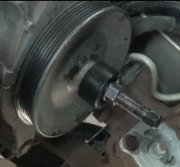Hi and thanks for using 2CarPros. Com. This is an interesting problem. Yes, the rack can be plugged causing a build up of pressure. You could try flushing the system. Also, there is a pressure control valve/direction flow valve. There is a chance the problem is coming from there. Here are directions to remove and replace it. I would suggest that you give it a try and check for any obstructions. I realize the pumps are new, but dirt can still enter them.
Remove the O-ring union fitting (5) from the hydraulic pump housing assembly (1).
Remove the O-ring seal (4) from the O-ring union fitting (5).
Remove the control valve assembly (3).
Remove the flow control spring (2).
Assembly Procedure
Install the flow control spring (2) to the hydraulic pump housing assembly (1).
Install the control valve assembly (3).
Lubricate the O-ring seal (4) with power steering fluid.
Install the O-ring seal (4) onto the O-ring union fitting (5).
Notice: Refer to Fastener Notice in Service Precautions.
Install the O-ring union fitting (5) into the hydraulic pump housing assembly (1). Tighten the fitting (5) to 75 Nm (55 ft. Lbs.).
The following picture correlate with these directions. (Pic 1)
Since the line needs replaced, you will have to bleed the system again. Here are directions specific to your vehicle for proper bleeding of the system. Note, it requires a vacuum being placed on the system and not the traditional turn the steering from lock to lock. Additionally, there are suggestions related to the system not holding pressure. Pictures 2, 3, 4 correlate with these directions.
Bleeding the Power Steering System
Tools Required
J35555 Metal Mityvac
J43485 Power Steering Bleeder Adapter
Important: Hoses touching the frame, body, or engine may cause system noise.
Verify that the hoses do not touch any other part of the vehicle.
Important: Loose connections may not leak, but could allow air into the steering system.
Verify that all hose connections are tight.
Notice: If the power steering system has been serviced, an accurate fluid level reading cannot be obtained unless air is bled from the steering system. The air in the fluid may cause pump cavitation noise and may cause pump damage over a period of time.
Important: Maintain the fluid level throughout the bleed procedure.
Remove the pump reservoir cap.
Important: Use clean, new power steering fluid only.
Fill the pump reservoir with fluid to the FULL COLD level.
Attach the J43485 to the J35555 or equivalent.
Place the J43485 on or in the pump reservoir filler neck.
Apply a vacuum of 68 kPa (20 in Hg) maximum.
Wait 5 minutes. Typical vacuum drop is 7 - 10 kPa (2 - 3 in Hg). If the vacuum does not remain steady, refer to Excessive Vacuum Drop Diagnosis.
Remove the J43485 and the J35555.
Reinstall the pump reservoir cap.
Start the engine. Allow the engine to idle.
Turn off the engine.
Verify the fluid level. Repeat steps 11-13 until the fluid stabilizes.
Important: Do not turn steering wheel to lock.
Start the engine. Allow the engine to idle.
Turn the steering wheel 180 - 360 degrees in both directions 5 times.
Switch the ignition off.
Notice: When adding fluid or making a complete fluid change, always use the proper power steering fluid. Failure to use the proper fluid will cause hose and seal damage and fluid leaks.
Verify the fluid level.
Remove the pump reservoir cap.
Attach the J43485 to the J35555 or equivalent.
Place the J43485 on or in the pump reservoir filler neck.
Apply a vacuum of 68 kPa (20 in Hg) maximum.
Wait 5 minutes.
Remove the J43485 and the J35555.
Verify the fluid level.
Reinstall the pump reservoir cap.
Excessive Vacuum Drop Diagnosis
If the vacuum continues to drop, remove the pressure and return hose from the pump.
Install the plugs (1, 2) supplied with the J43485 into the pressure and return port.
Attach the J43485 to the J35555 or equivalent.
Place the J43485 on or in the pump reservoir filler neck.
Apply a vacuum of 68 kPa (20 in Hg) maximum.
If the vacuum drops again, repair or replace the pump. If the vacuum holds steady, continue to check the other parts of the steering system.
Important: Fluid must be free from bubbles and foam. Be aware of periodic bubbles that indicate a loose connection or leaking O-ring seal in the return hose or the pressure hose.
Fluid must be free from discoloration.
Observe the fluid.
If condition persists, replace the following parts:
The return hose clamps
The return hose O-rings
The pressure hose O-rings
The gear cylinder line O-rings
The reservoir to pump O-ring
Repeat the bleed procedure from the beginning.
Drive the vehicle approximately 16 km (10 miles) in order to warm the system to operating temperature. Evaluate vehicle on a smooth flat surface.
Verify the following conditions:
There is smooth power assist.
The vehicle operates quietly.
The pump maintains the proper fluid level.
There is not any leaking in the steering system.
The fluid is free of foam or discoloration.
Picture 5 is of the pressure the system should maintain.
Here are directions for checking the pressure:
With the engine off, install the pressure gauge between the high pressure hose and the pump.
Start the engine and allow it to warm up with the pressure gauge in the open position
Turn the steering several times to circulate the fluid.
Close the valve on the gauge for NO MORE THAN 5 Seconds or overheating and damage will occur.
When in the closed position, document the pressure and compare it to the cart I provided.
The last picture is of the gauge set up.
I hope this is helpful. Let me know if you have other questions.
Take care,
Joe
Images (Click to make bigger)
Thursday, May 24th, 2018 AT 8:28 PM








